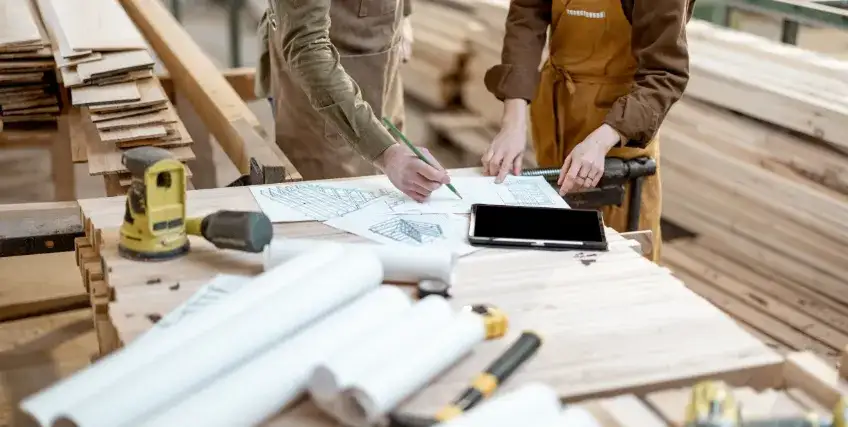Power Your Next Project
With a Carpentry Business Loan
Looking for Business Financing?
Apply now for flexible business financing. Biz2Credit offers term loans, revenue-based financing, and commercial real estate loans to qualified businesses.
Set up a Biz2Credit account and apply for business financing
If your woodworking shop is getting more project requests than you can handle, you're not alone. The carpentry industry in the U.S. is buzzing. Residential renovations, custom cabinets, furniture demand, and commercial fit-outs are all driving this rise.
But here’s the thing: no matter how skilled your team is, without cash flow, you can't grow. That’s where a loan for carpentry business steps in. Whether it’s buying new equipment, hiring labor, or prepaying for lumber, funding gives you a shot at scaling your craft without burning out.
Carpenters often juggle multiple projects with upfront costs, long pay cycles, and surprise expenses. A good loan doesn’t just help you survive; it helps you compete. Especially when big jobs come knocking and you need fast access to working capital.
We’ll break down how to use business loans, and what kinds of financing options are out there.
Where Carpentry Businesses Spend Their Loan Funds
Getting a loan for carpentry business isn’t just about having funds in the bank. It’s about using it smartly to keep projects on schedule and clients happy.
Here’s where U.S. carpenters put that money to work:
1. Tools, Equipment, and Upgrades
Carpenters rely on precision. A dull blade or outdated gear slows you down. That’s why many use their loan for carpentry business to invest in equipment financing. From table saws to compressors, every upgrade improves turnaround and safety. And when tech evolves, keeping up can separate your shop from the rest. Financing helps you avoid dipping into your savings just to stay competitive.
2. Payroll and Skilled Labor
No project gets done without people. Whether it’s a short-term contract or hiring full-time talent, cash flow is key. A loan for carpentry business can fund payroll during off-seasons or help you onboard a crew for large commercial jobs. Skilled labor costs more, sure, but quality finishes bring repeat clients. With flexible repayment terms, you don’t have to worry about going dry before the invoice clears.
3. Materials and Upfront Costs
Lumber, fasteners, adhesive - those costs add up fast. A big job might require thousands in upfront material costs before you see a dime. That’s where a loan for carpentry business becomes a lifesaver. Whether you’re doing framing or finishing work, having access to working capital ensures you’re not stuck delaying projects because of funds. Better yet, you can lock in materials early and avoid market price spikes.
Common Types of Loan for Carpentry Business
There’s no single loan that works for every carpentry business. Some jobs need quick cash, while others require long-term planning. So, what are your options?
Let’s break down a few funding paths carpenters often turn to.
1. Term Loan
You borrow a fixed loan amount and repay it over time, usually at a fixed rate. A term loan works well for buying new machinery or investing in a workshop upgrade. With predictable payments, you can plan around other expenses like labor or down payments. Just know that credit score and business history will matter here. A strong business plan helps get your foot in the door.
2. Business Line of Credit
A business line of credit offers flexibility. You pull funds only when needed like buying a sudden stock of cedar or covering a subcontractor’s invoice. Many carpentry industry financing users lean on this during slow seasons or unpredictable builds. It’s great for cash flow, but interest kicks in only when you use the credit. Unlike credit cards, this option is designed for short-term, project-based borrowing.
3. Equipment Financing
With equipment financing, the loan is backed by the gear itself, reducing the need for additional collateral requirements. It’s a smart way to preserve cash while still growing. If your carpentry business needs a dust collector, laser cutter, or delivery truck, this financing fits the bill. Many business owners use this option when replacing aging equipment.
SBA Loans for Carpentry Businesses: Why They're a Solid Bet
Plenty of carpenters eye an SBA loan when they need funding and for good reason. Backed by the Small Business Administration, these loans may offer better terms than some bank options.
Here’s why many use an SBA loan for carpentry business funding.
1. Lower Interest and Longer Terms
With SBA loans for carpentry businesses, you may be able to get lower interest rates and generous repayment terms. That’s a game-changer for small shops juggling payroll, materials, and rent. You don’t have to scramble every month to cover steep payments. SBA 7(a) and SBA 504 loan programs are the most common options. These allow you to spread payments over 10 to 25 years, making big purchases more manageable.
2. Perfect for Equipment or Real Estate
SBA loans work for more than just working capital. You can use them to buy commercial real estate, finance long-term expansion, or purchase high-ticket tools. Many carpenters use the loan for carpentry business to move into larger spaces or open a second workshop. An SBA 504 loan is especially useful here, helping you lock in fixed, long-term financing for real estate and heavy-duty machinery.
Weighing the Pros and Cons of a Carpentry Business Loan
A loan for carpentry business can push your shop forward but it also comes with responsibility. Let’s weigh the upsides and the not-so-great parts before you apply.
Pros
1. Helps Fund Expansion
One of the biggest benefits of a small business loan is the ability to grow. Want to hire new hands? Open a second location? You’ll need upfront cash. Loans let you expand at the right moment, not when you’ve saved up for years. Growth moves faster when you’re not stuck waiting for extra capital.
2. Improves Cash Flow Stability
Jobs get delayed. Clients pay late. But your bills don’t wait. Access to working capital ensures your team gets paid, materials are bought, and no project stalls. A loan for carpentry business gives you that breathing room to manage dry spells without halting operations.
3. SBA Loans May Offer Better Terms
The benefits of SBA loans include friendlier interest rates, and flexible repayment.
Cons
1. Can Add Monthly Pressure
Even if business is slow, that loan payment still shows up. Whether you’ve closed a deal or not, repayments must be made. If you don’t have steady cash flow, it can add stress instead of relief.
2. Qualification Takes Time
Banks and lenders want proof, such as business plan, credit score, income statements, even personal guarantees. Applying for a loan for carpentry business isn’t always fast. Some loan programs can take weeks. That lag may cost you a client if you're in a time crunch.
Loan Repayment: What Carpentry Business Owners Should Know
Getting approved is just half the game. What happens after matters more. Repaying a loan for carpentry business needs planning, discipline, and real-time cash management. Let’s look at what repayment really means.
Benefits of Loan for Carpentry Business
1. Predictable Monthly Payments
If you opt for a fixed rate loan, you’ll know exactly what’s due every month. That helps you manage cash flow, plan purchases, and avoid nasty surprises. Most term loans and SBA 504 loans follow this structure. For many carpenters, knowing the number is better than guessing.
2. Repayment Can Build Credit History
Every on-time repayment boosts your credit score and makes future borrowing easier, if the lender reports to credit bureaus . Lenders see you as reliable, and that unlocks better loan options later. Carpentry shops looking to scale into construction might someday need commercial real estate loans or refinancing help. So, your past repayment behavior helps with that.
Drawbacks of Loan for Carpentry Business
1. Early Repayment Penalties
Some lenders charge you for paying off early. If your loan process wasn’t clearly explained, these fees can surprise you. Always read the terms before signing the loan application.
2. Variable Interest Rate Risk
Got a line of credit or floating-rate loan? Your interest rate could rise suddenly, increasing your monthly dues. That’s fine when jobs are rolling in. But if a project falls through, higher rates can throw your finances off balance. Many carpenters prefer fixed terms for that very reason.
Alternative Financing Options for Carpenters Who Need Flexibility
Not every loan for carpentry business comes from a big-name lender or a bank. Plenty of carpenters find creative paths to get funded and fast. Let’s explore a few.
1. Credit Unions and Community Banks
Local credit unions or community lenders often offer decent business loans with better service and flexibility. Many understand niche industries like carpentry and offer programs fit for small shops. These institutions sometimes partner with non-profit or state programs to support micro-enterprises or construction firms looking for equipment or a small loan amount to get started.
2. Grants and Government Aid
Not every carpentry industry financing source is repayable. Some government grants, especially for green construction, rural development, or veteran-owned businesses, are worth exploring. While competitive, these grants don’t require repayment. A good business plan improves your odds.
3. Construction Loans from Specialty Lenders
If your carpentry work overlaps with general contracting or building, construction loans may apply. These loans are typically based on projected project value. The funds are released in phases tied to completion milestones. Not every carpenter qualifies, but if you handle full-scale renovations or structural work, it’s worth exploring.
Trusted by Thousands of Small Business Owners in America.**
Simply because we get what you go through to build a business you believe in.
**Disclaimer: All stories are real, as told by real business owners. Customers do not receive monetary compensation for telling their stories.
From One Entrepreneur to Another: We Get You
We understand what's behind building a business you believe in.
All stories are real, as told by real business owners. Customers do not receive monetary compensation for telling their stories.



Articles on Loan for Carpentry Business
How to Use a Business Loan to Expand Your Carpentry Services
Your projects might stack up, clients may expect more, and expanding services can feel like a challenge. At this point, relying only on savings or credit cards...
Need Funds for Your Carpentry Business? Here Are the Popular Loan Solutions
Carpenters always know the right tool for the job. The same principle applies to small business. Just as you can’t build a custom cabinet without a quality saw...
Is a Small Business Loan Right for Your Carpentry Company
As a small business owner, you run a small carpentry shop in a busy American town. Your orders are steady, but the challenges never seem to slow down...
Frequently Asked Questions About Loans for Carpentry Business
1. How can I qualify for a loan for carpentry business?
You’ll typically need a solid business plan, steady revenue, and a decent credit score. Lenders also look at your experience, collateral, and how you’ll use the funds. Some SBA loans for carpentry businesses may be easier to qualify for than traditional options, especially for newer shops.
2. Can I use SBA loans for payroll or rent?
Many SBA loans for carpentry businesses allow funds to cover operating costs like payroll, rent, or vendor payments. Just be clear in your loan application and match the use to the loan’s approved purpose.
3. Do I need collateral for carpentry business financing?
Some loans may require collateral, such as equipment, vehicles, or even real estate. But SBA loan programs reduce or waive those collateral requirements. It varies by lender and loan type.
4. Can part-time carpenters apply for a loan for carpentry business?
It’s a bit trickier. If you operate part-time, lenders may want proof that your income is steady and your business purpose is legit. Strong loan documentation, consistent earnings, and a well-structured business plan can help you qualify for a loan for carpentry business even without full-time hours.
5. Are there financing options for mobile or home-based carpenters?
Whether you run your shop from a garage or a truck, you can still apply for a loan for carpentry business. Look into short-term loans, credit unions, or SBA microloans. The key is showing you have clients and cash coming in, regardless of location.
Frequent searches leading to this page
Term Loans are made by Itria Ventures LLC or Cross River Bank, Member FDIC. This is not a deposit product. California residents: Itria Ventures LLC is licensed by the Department of Financial Protection and Innovation. Loans are made or arranged pursuant to California Financing Law License # 60DBO-35839



